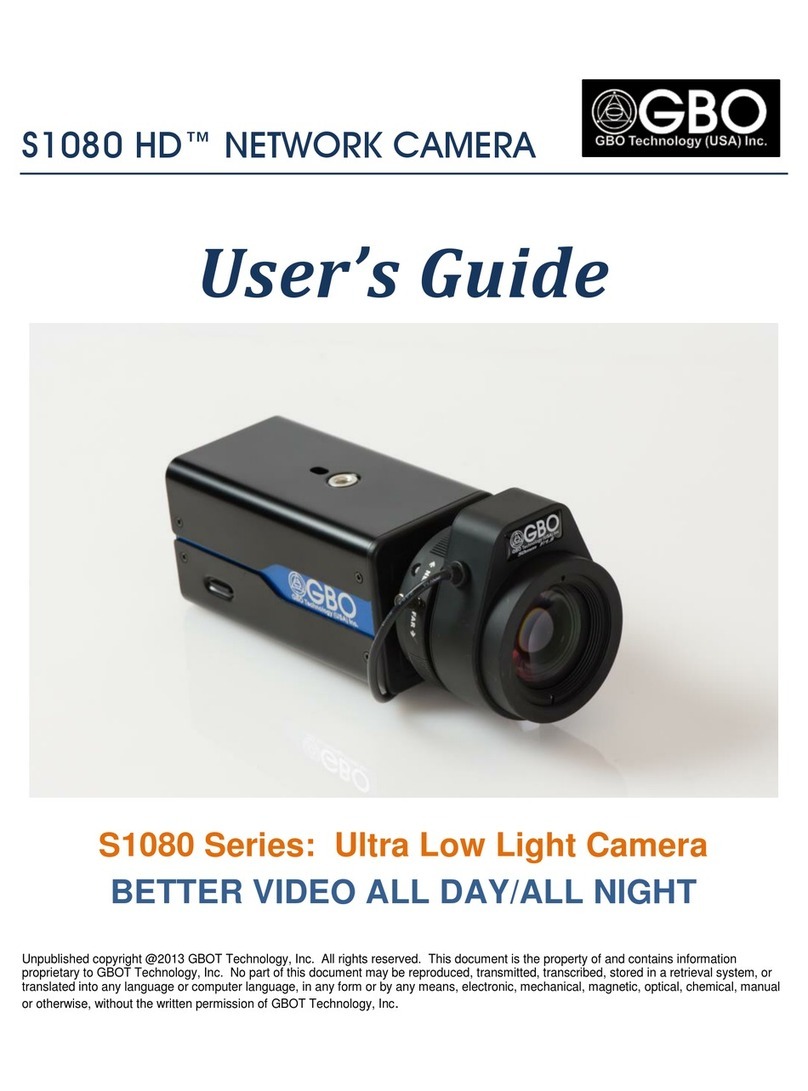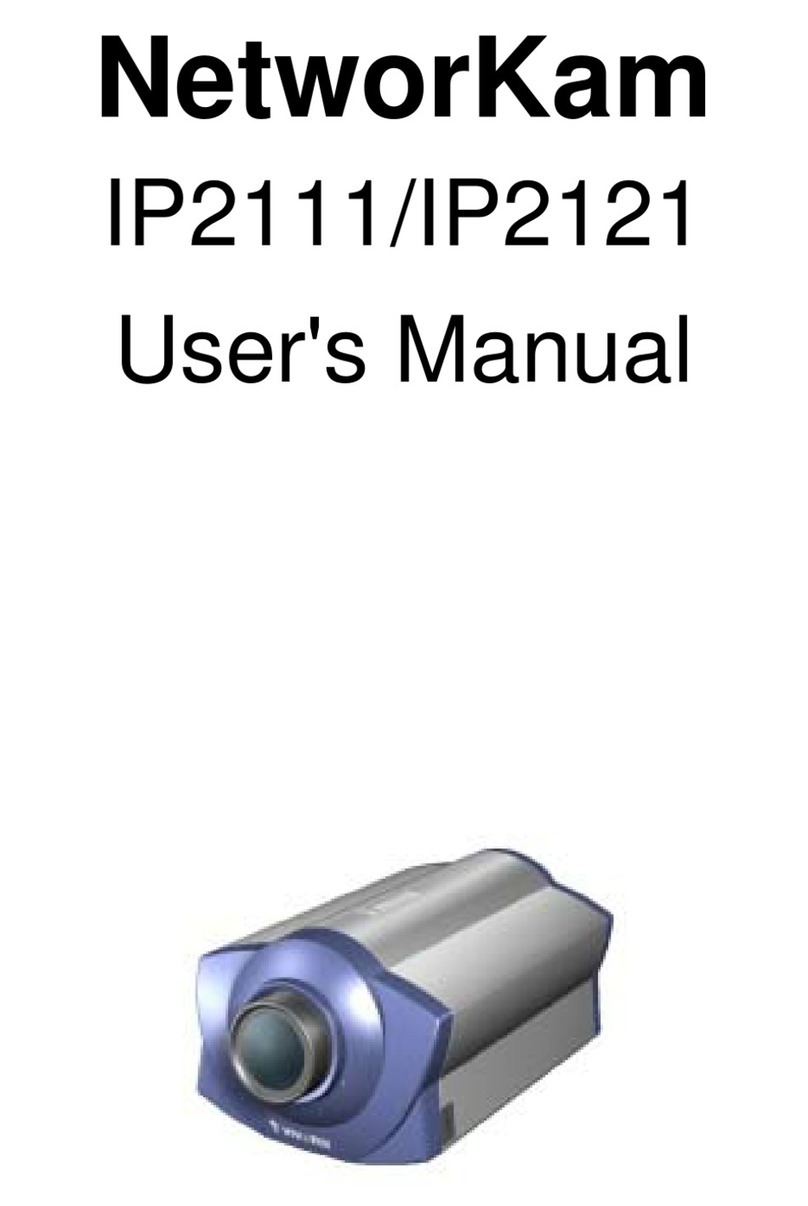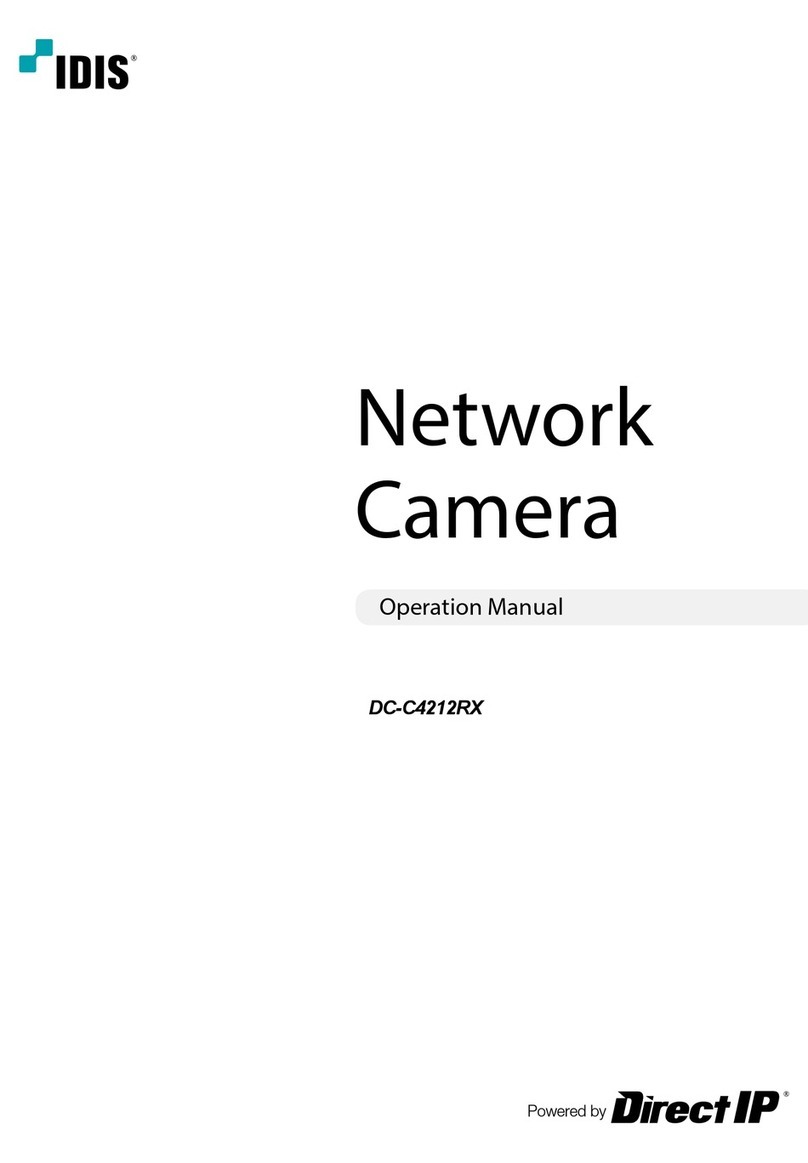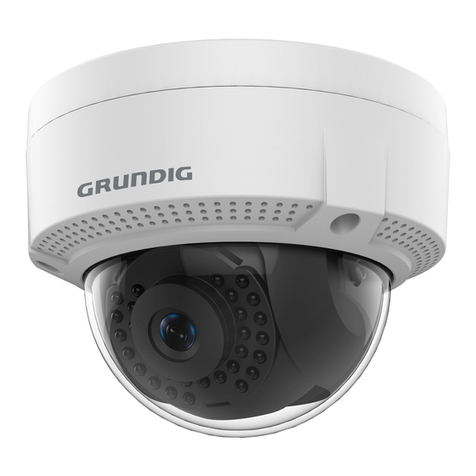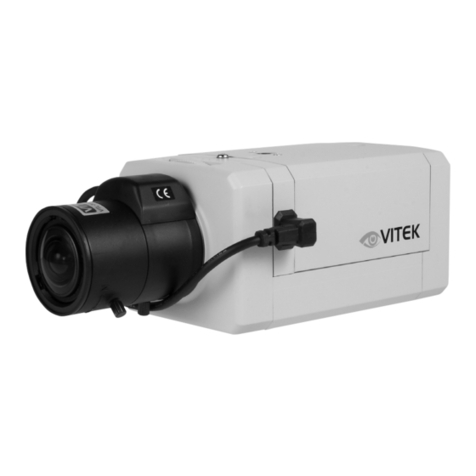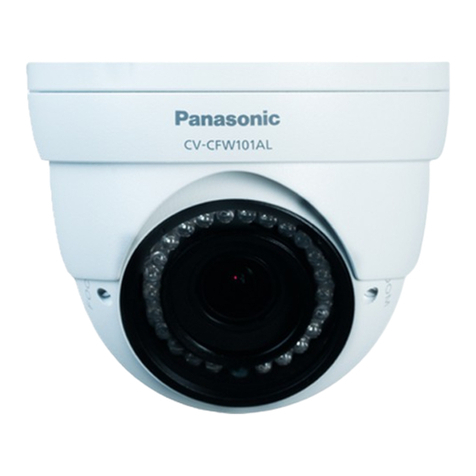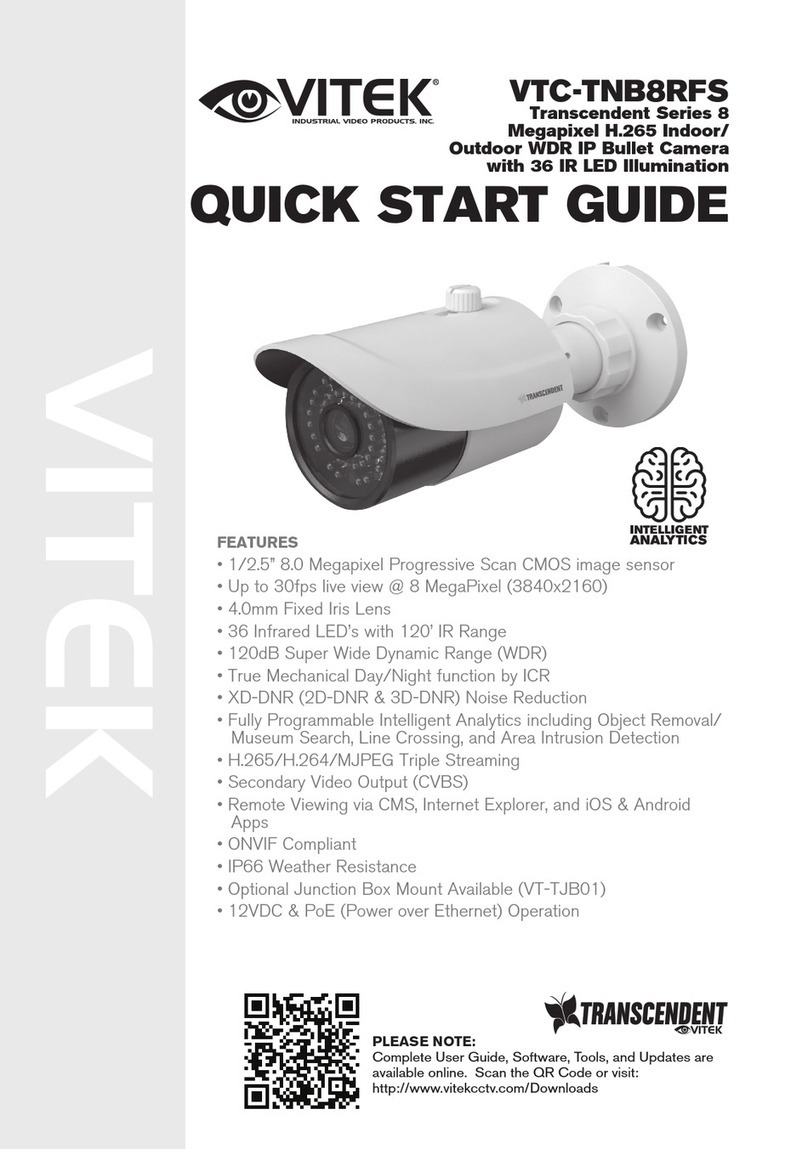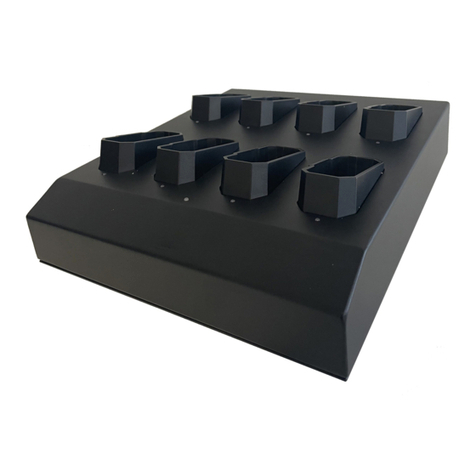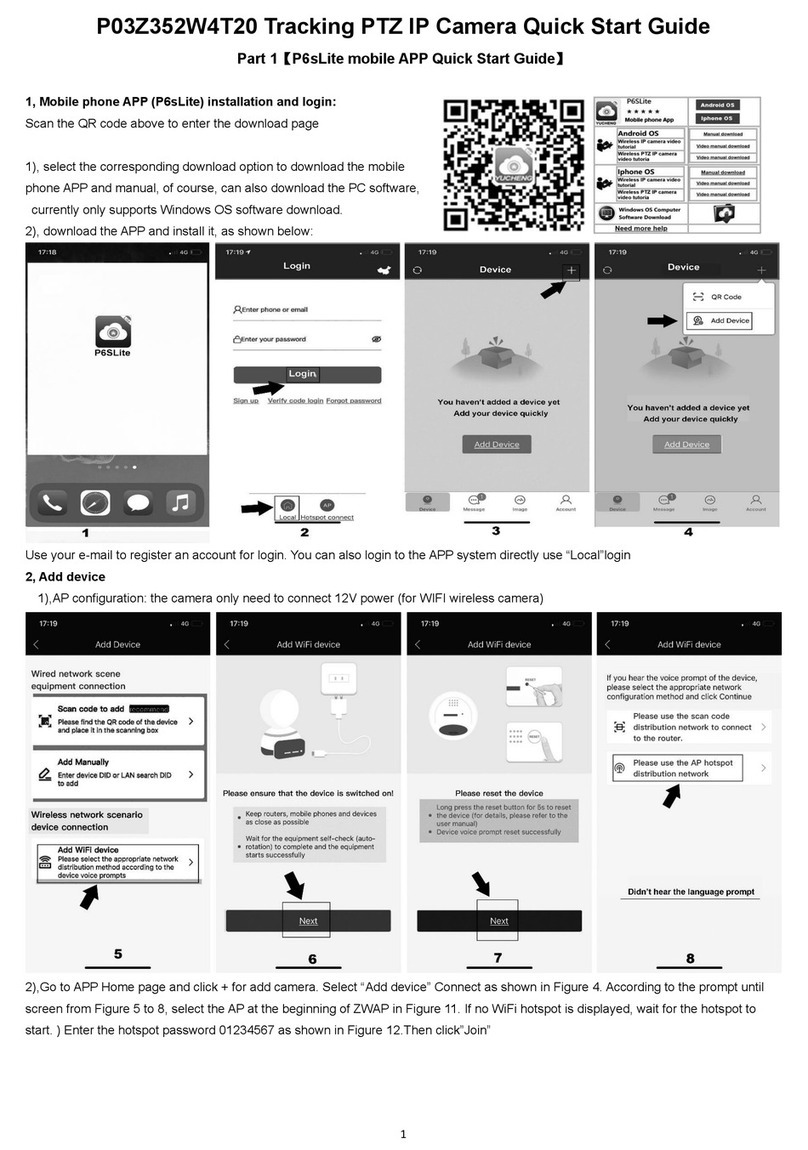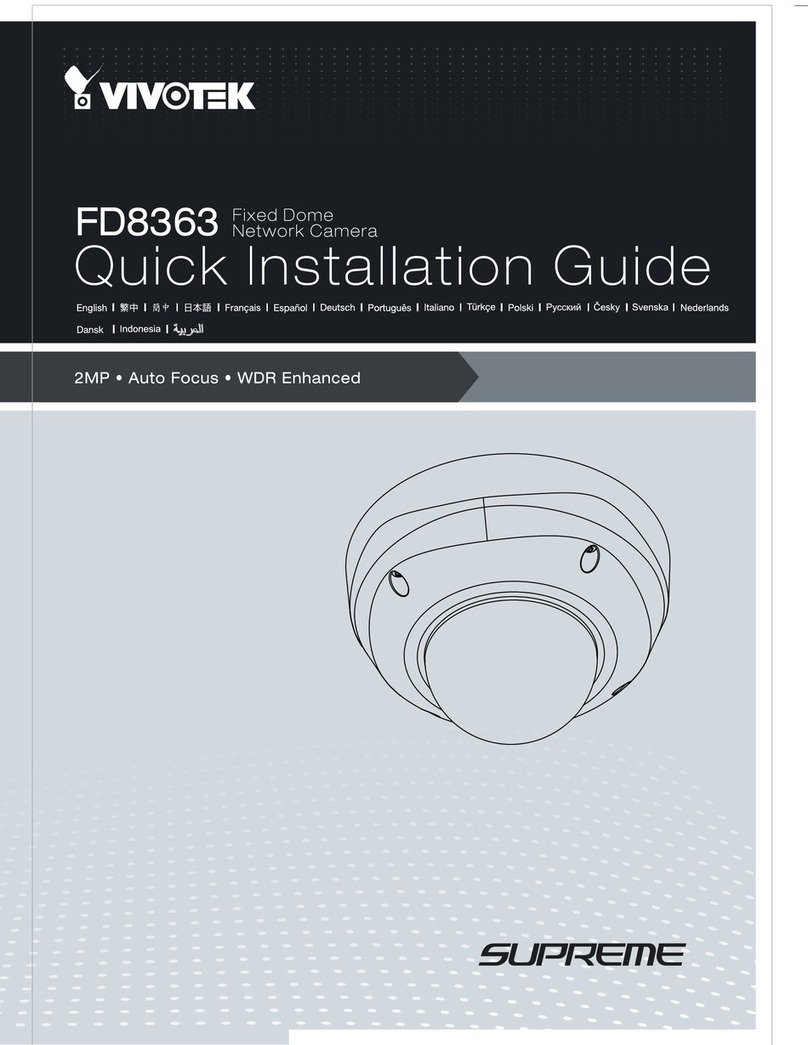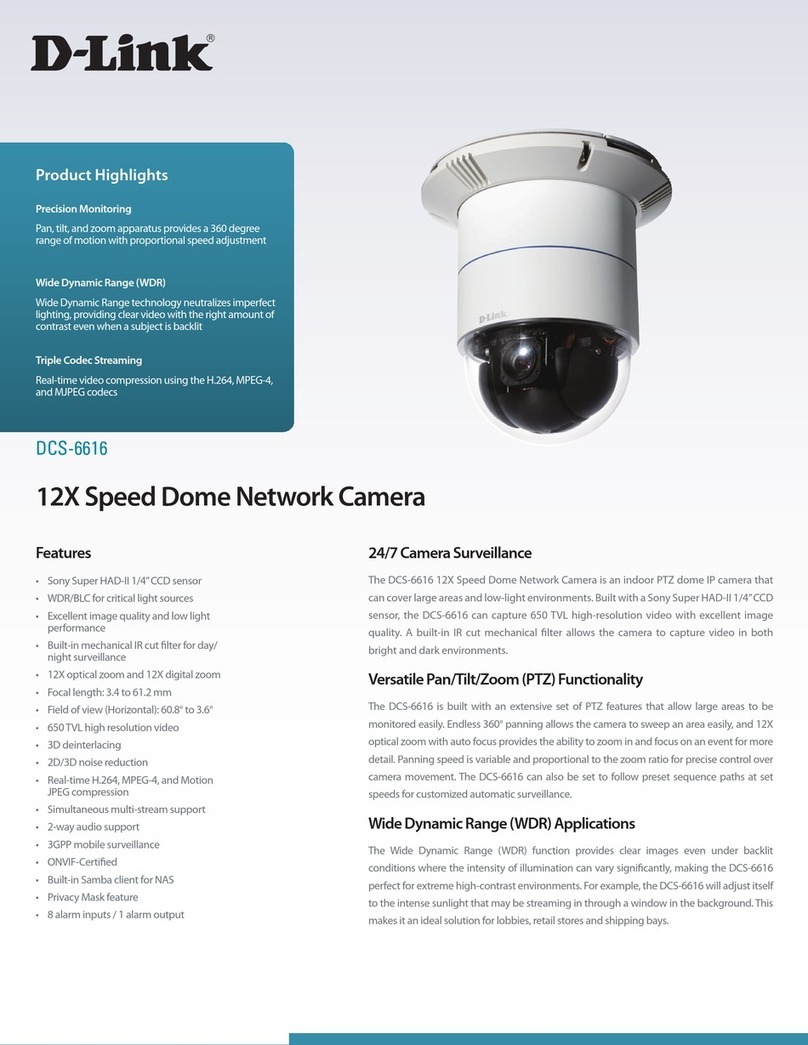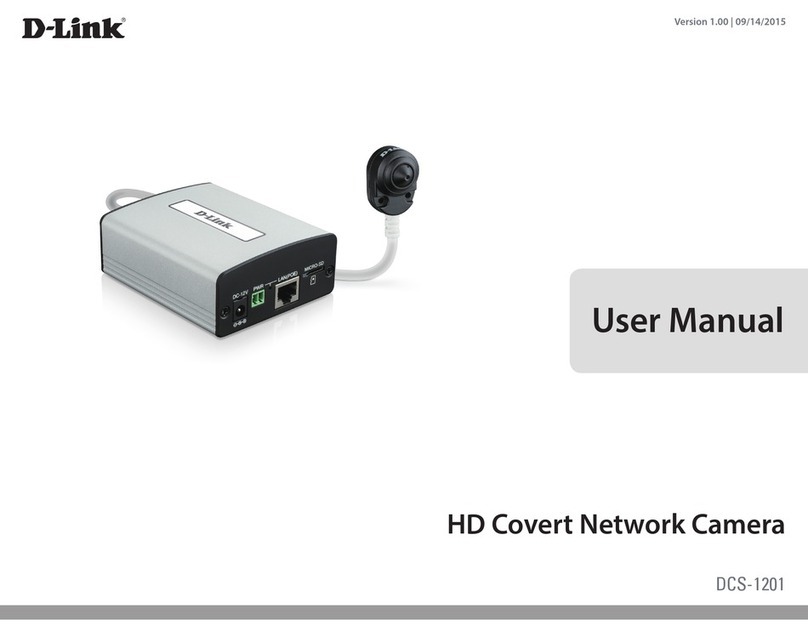GBO Technology S1080 Series User manual

S1080 IP NETWORK CAMERA
Quick Reference
Guide

United States
Offices and Customer Service
Intelligence Video LLC
Address: 4039 Transport St., STE 104
Palo Alto, CA 94303
USA
Phone:+1 650 877 2911
E-mail: [email protected]
Unpublished copyright @2016 Intelligence Video, LLC. All rights reserved. This document is the property of
and contains information proprietary to Intelligence Video, LLC. No part of this document may be reproduced,
transmitted, transcribed, stored in a retrieval system, or translated into any language or computer language, in
any form or by any means, electronic, mechanical, magnetic, optical, chemical, manual or otherwise, without
the written permission of Intelligence Video, LLC.

Quick Reference Guide
QRG-S1080-1000
Revision C
Feb 22, 2016 Company Proprietary Information Page i of ii
Table of Contents
1.0
CONFIGURE THE CAMERA FOR THE LENS TYPE...................................................................................................1
2.0
INSTALL THE CAMERA FOR THE FIRST TIME .......................................................................................................1
2.1
Camera Connected Directly to a Personal Computer ......................................................................1
2.2
Standalone POE Switch Installation.................................................................................................5
2.3
UPNP- and DHCP-Enabled Network Installation .............................................................................6
2.4
Use DCHP to Obtain an IP Address Automatically ..........................................................................7
3.0
WEB BROWSER GUI SCREEN...........................................................................................................................8
3.1
Select Stream(s) to View ..................................................................................................................8
3.2
Icons .................................................................................................................................................8
4.0
ADD/EDIT USERS SCREEN................................................................................................................................9
5.0
VIDEO SETTINGS............................................................................................................................................10
5.1
Advanced Video Settings ...............................................................................................................12
5.2
Face Detection - Region of Interest................................................................................................12
6.0
ADVANCED FEATURES SCREEN ......................................................................................................................13
7.0
CAMERA ........................................................................................................................................................14
7.1
Camera – Advanced Settings.........................................................................................................15
7.2
Camera – Pan/Tilt...........................................................................................................................15
7.3
Alignment Controls .........................................................................................................................16
8.0
AUDIO ...........................................................................................................................................................16
9.0
DATE/TIME ....................................................................................................................................................17
10.0
NETWORK AND PORT SCREEN ........................................................................................................................18
11.0
ALARM ..........................................................................................................................................................19
12.0
STORAGE ......................................................................................................................................................21
12.1
Create a Recording Schedule ........................................................................................................21
12.2
Upload Files at the Storage Screen ...............................................................................................22
12.3
Upload Files At the Alarm Screen ..................................................................................................22
List of Figures
Fig re 1 Back of Camera Showing DIP #1 in Position 2 ........................................................................................ 1
Fig re 2 Camera Connected Directly to PC ........................................................................................................... 2
Fig re 3 OnVIF Main Screen and Log In ................................................................................................................ 2
Fig re 4 Wrench Icon and Application Settings Screen ........................................................................................ 3
Fig re 5 Internet Explorer Screen ......................................................................................................................... 3
Fig re 6 Internet Options...................................................................................................................................... 4
Fig re 7 S1080 IP Network Camera Log In Screen ................................................................................................ 4
Fig re 8 Web Browser GUI Screen (Live Video Screen) ........................................................................................ 4
Fig re 9 Set Browser Window Size ....................................................................................................................... 5
Fig re 10 PC to Standalone POE Switch to Camera ................................................................................................ 5
Fig re 11 Back of Camera and POE Switch ............................................................................................................. 5
Fig re 12 PC to POE Switch to Cameras ................................................................................................................. 6
Fig re 13 UPnP Icon for S1080 IP Network Camera ............................................................................................... 6
Fig re 14 Ethernet Icon .......................................................................................................................................... 7
Fig re 15 Live Video Screen .................................................................................................................................... 8
Fig re 16 Live Video Screen Icons ........................................................................................................................... 8
Fig re 17 Add/Edit Users Screen ............................................................................................................................ 9
Fig re 18 Video Screen ......................................................................................................................................... 10
Fig re 19 Advanced Video and Region of Interest Screens .................................................................................. 12
Fig re 20 Advanced Feat res Screen .................................................................................................................... 13

QRG-S1080-1000
Revision C
Quick Reference Guide
Page ii of ii Company Proprietary Information Feb 22, 2016
Fig re 21 Camera Settings Screen ........................................................................................................................ 14
Fig re 22 Camera > Pan/Tilt Screen...................................................................................................................... 15
Fig re 23 A dio Setting Screen ............................................................................................................................. 16
Fig re 24 Date/Time Screen ................................................................................................................................. 17
Fig re 25 Network and Port Screen ...................................................................................................................... 18
Fig re 26 Alarm Screen ......................................................................................................................................... 19
Fig re 27 Storage Screen ...................................................................................................................................... 21
List of Tables
Table 1 Video Screen Selections ........................................................................................................................ 10
Table 2 Camera Settings .................................................................................................................................... 14
Table 3 Pan/Tilt Settings .................................................................................................................................... 15
Table 4 A dio Settings ....................................................................................................................................... 16
Table 5 Date and Time Settings ......................................................................................................................... 17
Table 6 Alarm Settings ....................................................................................................................................... 19
Touch Screen Users:
Touch Screen Users:Touch Screen Users:
Touch Screen Users:
The instructions in this manual are written for regular personal computers. For touch
screen computers, simply su stitute the word "touch" for "click on" or "select".

Quick Reference Guide
QRG-S1080-1000
Revision C
Feb 22, 2016 Company Proprietary Page 1 of 22
1.0 CONFIGURE THE CAMERA FOR THE LEN TYPE
The two most commonly sed types of lenses on the S1080 IP Network Camera are the man al iris lens and the DC Iris
(direct control iris) lens. The factory-set defa lt is for the man al iris lens.
If a manual iris lens is being sed, the camera is pre-config red and req ires no action.
If a DC Iris lens is being sed, a DIP switch setting on the back of the camera needs to be changed.
At the back of the camera there are two DIP switches, #1 and #2. Flip DIP switch #1 into position 2 when sing a DC Iris
lens (as shown in Fig re 1).
Figure 1 Back of Camera Showing DIP #1 in Position 2
2.0 IN TALL THE CAMERA FOR THE FIR T TIME
There are three ways to install the S1080 IP Network Camera:
(1) By connecting the camera directly to yo r personal comp ter (PC). See Section 2.1, Camera Connected Directly
to a Personal Computer.
(2) By connecting the camera to a standalone Power-over Ethernet (POE) switch that is connected to yo r PC.
See Section 2.2, Standalone PO Switch Installation.
(3) By connecting it to a network via a POE switch. See Section 2.3, UPNP- and DHCP- nabled Network Installation.
2.1 Camera Connected Directly to a Personal Computer
These instr ctions describe how to se the OnVIF Device Manager application to interface with the camera’s software
with the camera connected directly to a standalone PC.
Step 1. Download “OnVIF Device Manager”
From the internet, download the OnVIF Device Manager application from
http://so rceforge.net/projects/onvifdm/. After the application has down-loaded, the OnVIF icon displays on
yo r desktop.
Step 2. Power On Standalone PC
Before connecting the camera, power-on the standalone PC, witho t the Ethernet cable connection, and second,
ens re that the PC’s Ethernet interface is config red to se DHCP to obtain an IP address a tomatically. See Section,
2.4, Use DCHP to Obtain an IP Address Automatically, for detailed information on req ired PC settings.
DIP Switch #1
in position 2
LAN LED
Power
LED

QRG-S1080-1000
Revision C
Quick Reference Guide
Page 2 of 22 Company Proprietary Information Feb 22, 2016
Step 3. Connect Camera to Your Computer
Using an Ethernet cable, connect one end of the cable to the LAN/POE slot in the back of the camera and the other end
to yo r comp ter (see Fig re 2).
Figure 2 Camera Connected Directly to PC
Step 4. Power On Camera with DC Power Supply
Insert the connector end of the camera’s power s pply cable into the DC 12V receptacle located on the back
of the camera. Pl g the electrical end of the power s pply cable into a power o tlet.
Wait ntil the two camera LEDs light p. Initially they are red/orange in color; when they both t rn green,
the camera is “on” and working correctly (see Fig re 1)
Step 5. Open “OnVIF Device Manager”
Open the OnVIF application by do ble-clicking on its icon on yo r desktop and its Main Screen opens.
At the OnVIF Main Screen, check the Remember checkbox (see Fig re 3).
Enter yo r Name (admin) and Password (9999).
Figure 3 nVIF Main Screen and Log In
Click on the Log in b tton.
Yo r camera’s IP address is shown in the gray box as Address.
Step 6. Change Settings
Click on the wrench icon located at the top right side of the OnVIF Main Screen (see Fig re 4). The
Application settings dialog box opens.
Name
Password
Log in
button
Your camera’s
IP Address
Ethernet able LAN/POE/slot
Remember
checkbox
Standalone P amera

Quick Reference Guide
QRG-S1080-1000
Revision C
Feb 22, 2016 Company Proprietary Page 3 of 22
Figure 4 Wrench Icon and Application Settings Screen
Change the Video rendering fps to 15. Click on Open web in external browser checkbox.
Change Video streaming transport to UDP from the drop-down list. Click on the Apply b tton and wait for
the changes to take effect.
Step 7. Open Web Page
At the OnVIF Main Screen (see Fig re 3), click on Web page and a black screen opens with a message that
asks yo to allow add-ons before the S1080 IP Network Camera Log In Screen can be opened.
Click on the Allow b tton, and the S1080 IP Network Camera Log In Screen opens with the same q estion at
the bottom of the screen.
Click on the Allow b tton again, and yo can log in (see Step 10, Log In). Skip Step 7 and Step 8.
NOTE
:
If the S1080 IP Network Camera Log In Screen does not open after approximately one minute, the default
Home Page setting on your rowser may e causing a long timeout. Follow the instructions in Step 7, Set
Browser Default to Blank, elow, to correct this.
Step 8. Set Browser Default to Blank
At yo r Internet Explorer screen, click on the Settings icon located in the pper right-hand corner of
the screen.
Figure 5 Internet Explorer Screen
Video rendering fps
Open web in
external
browser
Wrench icon
Apply button
UDP

QRG-S1080-1000
Revision C
Quick Reference Guide
Page 4 of 22 Company Proprietary Information Feb 22, 2016
Click on Internet options and the Internet Options dialog box opens.
Delete the text in the Home Page text box, and click on the OK b tton.
Step 9. Open Web Page – After Changing Browser Setting
Back at the OnVIF Main Screen, click on Web Page again (see Fig re 3).
Follow the steps in Step 7, Open Web Page and proceed to Step 9.
Step 10. Log In
Enter the User Name (admin) and Password (9999), and then click on
the Submit b tton (see Fig re 7).
After s ccessf l login, a live video from the camera starts streaming in
the Live Video section of the Web Browser GUI Screen (see Fig re 8).
Figure 7 S1080 IP Network Camera Log In Screen
Figure 8 Web Browser GUI Screen (Live Video Screen)
CAUTION:
If your Browser screen size is not set to 100%, the ottom of some uttons may e cut off. Follow the
instructions in Step , Set Browser Size, to set your Browser to the correct size.
Figure 6 Internet ptions
(1) Live Video
Section
(2) Navigation
Panel

Quick Reference Guide
QRG-S1080-1000
Revision C
Feb 22, 2016 Company Proprietary Page 5 of 22
Step 11. Set Browser Size
At the Internet Explorer screen, click on the Settings icon located in the pper right-hand corner of the
screen.
Select Zoom (100%) from the drop-down men , and then select 100% from the second drop-down men
(see Fig re 9). Yo r Browser window will now be the correct size.
Figure 9 Set Browser Window Size
2.2 tandalone POE witch Installation
This installation req ires the camera and yo r PC to be connected to a standalone POE switch via two Ethernet cables.
It ses the OnVIF Device Manager application to interface with the camera’s software.
Figure 10 PC to Standalone P E Switch to Camera
Step 1. Connect PC to PO Switch
Using an Ethernet cable, connect one end to the POE switch and the other to yo r PC (see Fig re 10).
Step 2. Power-On PC
First, power-on the PC to ens re that the PC’s Ethernet interface is config red to se DHCP to a tomatically obtain an
IP address. In this case, beca se there is no DHCP server r nning on the network, the PC will obtain an A to-IP address
in the 169.254.0.0 class B s bnet. See Section 2.4, Use DCHP to Obtain an IP Address Automatically, for detailed
information on req ired PC settings.
Step 3. Connect Camera to Standalone PO Switch
Using an Ethernet cable, connect one end of the cable to the LAN/POE slot in the back of the camera and the
other end to the POE switch (see Fig re 11). The POE switch provides DC power to the camera so that the
camera’s DC power cable is not needed.
Figure 11 Back of Camera and P E Switch
Ethernet able Ethernet able
Standalone POE Switch
LAN/POE/slot Ethernet
able POE Switch
Standalone P amera

QRG-S1080-1000
Revision C
Quick Reference Guide
Page 6 of 22 Company Proprietary Information Feb 22, 2016
Wait ntil the two camera LEDs light p. Initially they are red/orange in color; when they both t rn green,
the camera is “on” and working correctly (see Fig re 1).
Step 4. Use “OnVIF Device Manager”
Follow Steps 4-10 of Section 2.1, Camera Connected Directly to a Personal Computer.
2.3 UPNP- and DHCP-Enabled Network Installation
The S1080 IP Network Camera is designed to be sed on an IP network and needs an IP address. Most networks have
a DHCP server that a tomatically assigns an IP address to a connected device.
Step 1. Connect Camera(s) to PC Using thernet Cable(s) and PO Switch
Using a standard Ethernet cable, connect the power-over-Ethernet (POE) switch to yo r PC.
Using standard Ethernet cable(s) connect the POE switch to the camera(s) thro gh the LAN/POE
receptacle(s) located on the back of the camera(s).
Figure 12 PC to P E Switch to Cameras
Step 2. Power On Camera Through PO
The camera is powered- p thro gh the POE 802.3af-enabled network switch. (If POE s pport is not available, an
external 12V DC power s pply is req ired. See Step 3, Power On Camera with DC Power Supply, in Section 2.1,
Camera Connected Directly to a Personal Computer.)
Step 3. Starting the Web Browser GUI Using UPnP
By defa lt, the S1080 IP Network Camera has the User Plug and Play (UPnP) f nctionality enabled (see that the nable
UPNP checkbox is checked in the Network and Port Screen (see Fig re 25).
To start the Web Browser GUI, browse to the PC’s Network dialog box. Under Other Devices, do ble-click
the
GBO_DD:EE:FF
icon, where
DD:EE:FF
represents the last three bytes of the camera’s media access
control (MAC) address.
Figure 13 UPnP Icon for S1080 IP Network Camera
Ethernet able
Ethernet ables
amera’s MA address
UPnP S1080 icon
Networked P ameras
POE Switch

Quick Reference Guide
QRG-S1080-1000
Revision C
Feb 22, 2016 Company Proprietary Page 7 of 22
Internet Explorer needs the ser’s permission to r n the camera Web Browser GUI. As the three dialog
boxes display, select first Install, then select Install again, and then Allow, to proceed.
Step 4. Log In via Web Browser GUI
The S1080 IP Network Camera Log In screen displays when the connection to the S1080 IP Network Camera
has been s ccessf l. Enter the User Name (admin) and Password (9999), and then click on the Submit
b tton (see Fig re 7).
After s ccessf l installation and login, a live video from the camera starts streaming in the Live Video
section of the Web Browser GUI Screen, which has two sections: (1) the Live Video Section, and (2) the
Navigation Panel (see Fig re 8).
2.4 Use DCHP to Obtain an IP Address Automatically
To verify that yo r comp ter’s Ethernet interface is config red to a tomatically obtain an IP address, follow the steps
below.
On yo r desktop, right-click on the thernet icon and the Network and Sharing Center dialog box opens
(see Fig re 14). Go to step 3.
Figure 14 Ethernet Icon
Or, open yo r Control Panel and click first on Network and Internet, and when the Network and Internet
dialog box opens, click on Network Sharing Center.
When the Network and Sharing Center dialog box opens, click on Change adapter settings, and the
Network Connections dialog box opens.
Scroll down and do ble-click on Internet Protocol Version 4 (TCP/IPv4), and the Internet Protocol Version 4
(TCP/IPv4) Properties dialog box opens.
Ens re that both Obtain an IP address automatically and Obtain DNS server address automatically radio
b ttons are checked.
Click on the OK b tton to close the dialog box.

QRG-S1080-1000
Revision C
Quick Reference Guide
Page 8 of 22 Company Proprietary Information Feb 22, 2016
3.0 WEB BROW ER GUI CREEN
3.1 elect tream(s) to View
The Live Video screen is the defa lt Web Browser GUI Screen and displays when the software is opened. Three
stream selections are available for yo to view, either singly, from the drop-down list, or at the same time. The Stream
Type m st first be selected at the Settings
Video Screen (see Fig re 18) and the Display all streams check box m st
be enabled.
Figure 15 Live Video Screen
3.2 Icons
Click on any of the icons to perform ro tine tasks. Before they are operational, the icons have to be enabled and some
conditions have to be preset.
Figure 16 Live Video Screen Icons
1X Display Icon: Click on the 1X Display icon to expand the streaming video to the whole screen.
A scroll bar on the screen allows the ser to move p and down the screen. Click on the Close 1X Mode
b tton to close.
Snapshot Icon: Click on the Snapshot icon to capt re and store the first resol tion JPEG image
of whatever the camera is “seeing” right now.
Alarm Status Icon: The Alarm Status icon has to be enabled from the Settings →Alarm
screen, and an alarm trigger m st be selected, i.e., Motion Detected, thernet Lost, or Audio Alarm (see
Section 11.0, Alarm).

Quick Reference Guide
QRG-S1080-1000
Revision C
Feb 22, 2016 Company Proprietary Page 9 of 22
When any of the preset conditions are met, the alarm is triggered and the alarm icon changes from inactive to
activate. The alarm icon changes color from white to orange to give the ser a vis al signal that the alarm state
has changed.
Record Status Icon: The Record Status icon indicates whether the camera is actively
recording, or if it is in an inactive state. Recording may be initiated for a specified period of time or for
whenever an alarm is triggered. The conditions are set at the Settings →Alarm or Settings →Storage
screens (see Sections 11.0, Alarm and 12.0, Storage).
Audio Toggle Icon: Click on the Audio icon to toggle the so nd at the camera location from
OFF to ON. A pre-selected Warning signal may be initiated. The conditions are set at the Audio Setting
screen (see Section 8.0, Audio).
SD Card xplorer Icon: This icon is only available if an SD card has been previo sly inserted into
the SD receptacle in the camera. Otherwise, it is missing.
Logout Button: Click on the Logout b tton to close the Web Browser GUI screen.
4.0 ADD/EDIT U ER CREEN
AT the Live Video Screen (see Fig re 15), click on Add/ dit Users and the Add/ dit Users Screen opens. Yo can add
sers and/or edit ser names and password. Yo may also wish to change yo r password as soon as possible since the
defa lt password is the same for all cameras and is factory set.
Click on the OK b tton to save yo r selections and wait for the changes to take effect.
Figure 17 Add/Edit Users Screen

QRG-S1080-1000
Revision C
Quick Reference Guide
Page 10 of 22 Company Proprietary Information Feb 22, 2016
5.0 VIDEO ETTING
At the Live Video Screen (see Fig re 15), click on Settings
Video and the Video Screen opens. Here yo make
selections to determine how the live streaming video will appear. These selections are described in Table 1, below.
Figure 18 Video Screen
Table 1 Video Screen Selections
Selection Action
. Camera Shows you the camera that is currently eing used.
2. Stream Type Select: Single, Dual, Tri-Stream
3. Codec Combo
1) Single: H.264, MPEG4, or Megapixel JPEG
2) Dual: H.264 + JPEG, MPEG4 + JPEG, Dual H.264, Dual MPEG4, or H.264 + MPEG4
3) Tri-Stream: Dual H.264 + JPEG, Dual MPEG4 + JPEG
4. Resolution* H.264, MPEG, JPEG
(Various settings, depending on Stream Type and Codec Combo settings.)
5. Stream Screens
1) Frame Rate
+
. Options include 1, 8, 15, 24, or 30 frames per second (fps).
2) Bit Rate
‡
. Values range from 64 to 12000 Kp s for Stream 1, and 64 to 8000Kp s for
Stream 3. Stream 2 does not have a it rate field
3) Rate Control: Off, VBR, or CBR (see S1080 User Manual for definitions)
4) Quality Factor (only Stream 2 has this field): Enter a value up to thirty.

Quick Reference Guide
QRG-S1080-1000
Revision C
Feb 22, 2016 Company Proprietary Page 11 of 22
Selection Action
6. Overlay Settings
1) Date. Click on Enable Date check ox to activate the date function.
2) Time. Click on Enable Time check ox to activate the time function.
3) Logo. Click on Enable Logo check ox to activate the logo function. Select a position for
the logo: top-left or top-right.
4) Text. Click on Enable Text check ox to activate the text function. This ena les insertion
of a pre-selected text onto the live video image. Enter the text into the field, and select a
position: top-right or top-left.
5) Detailed info. Select to insert camera information onto the live video screen.
7. H.264 profile Select: High, Base, or Main. Base is the least CPU intensive setting, and High is the most CPU
intensive setting.
8. Local Display Select: NTSC, PAL, or off.
9. Mirror Select: vertical, horizontal, oth, or off.
0. Video File Stream
Select which stream is to e saved: H.264(1280x720) or H.264(32x192).
. Video Size Select the length of the AVI file to e saved for either a scheduled recording or an Alarm
Trigger: 5 or 10 seconds.
*Resolution is image q ality and is meas red in megapixels. Pixels are the tiny light capt ring elements on the camera’s
sensor. The higher the n mber of pixels (or megapixels), the higher is the resol tion of the camera.
+
The frame rate is the n mber of frames or images that are transmitted over the network.
‡
The bit rate is the rate at which bits are transferred from one location to another. In other words, it meas res how m ch
data is transmitted in a given amo nt of time. A higher bit rate gives a better q ality image. Bit rate is commonly
meas red in bits per second (bps), kilobits per second (Kbps), or megabits per second (Mbps).
Click on the OK b tton to save yo r selections and wait for the changes to take effect.

QRG-S1080-1000
Revision C
Quick Reference Guide
Page 12 of 22 Company Proprietary Information Feb 22, 2016
5.1 Advanced Video ettings
Click on the Advanced b tton on the Video Screen and the Advanced Video Screen opens. Here yo can make
additional selections to control the live streaming video. These are advanced settings and are described in the S1080
User’s Manual. Setting a Region of Interest, where faces can be detected or masked, is described below.
Figure 19 Advanced Video and Region of Interest Screens
5.2 Face Detection - Region of Interest
Click on the nable Region of Interest (ROI) check box and a Configure Table (see Fig re 19) opens on top of
the screen.
Click on the Configure b tton and the Region of Interest screen opens. Drag the mo se to draw the Region.
Clicking on the Clear b tton removes the region.
Optionally, the ser can enter the val e directly into the X, Y, W and H text boxes. X and Y are the starting
coordinates of the region, and W and H are the width and height of the region. The entire region is selected
by defa lt.
Click on the OK b tton to save yo r selections and wait for the changes to take effect.
Regions of interest

Quick Reference Guide
QRG-S1080-1000
Revision C
Feb 22, 2016 Company Proprietary Page 13 of 22
6.0 ADVANCED FEATURE CREEN
Live Video Screen (see Fig re 15), click on Settings
Advanced Features, and the Advanced Features screen opens.
At this screen yo can config re how yo want motion and faces to be detected. Yo can also set privacy areas where
a black box blanks o t specified areas on the live video.
Figure 20 Advanced Features Screen
Config re these feat res the same way yo set the ROI (see Section 5.2, Face Detection - Region of Interest):
Click on the Configure b tton.
Click on nable Motion Window OSD indication (on-screen display) check box. Yo will receive vis al
feedback when motion is detected (flashing red boxes on the screen). The Motion Detection Alarm Trigger
m st first be enabled at the Settings
Alarm screen (see Section 11.0, Alarm, for more detailed
information).
Set the parameters when the screen opens and select areas by clicking on them with the mo se.
Click on the OK b tton to save yo r selections and wait for the changes to take effect.

QRG-S1080-1000
Revision C
Quick Reference Guide
Page 14 of 22 Company Proprietary Information Feb 22, 2016
7.0 CAMERA
At the Live Video Screen (see Fig re 15), click on Settings
Camera, and the Camera screen opens. At this screen yo
can set camera settings. These selections are described in Table 2, below. Refer to the Definitions section of the S1080
User’s Manual for more information on the parameters set at this screen.
Figure 21
Camera Settings Screen
Table 2 Camera Settings
Selection Action
. Lighting Condition:
a. Brightness Use the slider to specify the desired rightness level from 1 to 255. A higher value
of the rightness gives a righter scene.
b. Contrast Use the slider to specify the desired contrast level from 1 to 255.
c. Saturation Use the slider to specify the desired saturation level from 1 to 255. A higher value
of the saturation results in a more vivid scene.
d. Sharpness Use the slider to specify the desired sharpness level from 1 to 255.
2. Backlight
Specify: Min: Whole image average,
Mid: Center weighted
Max: Spot
3. Flicker Control Specify the desired frequency of flicker control. In PAL countries, use a
multiple of 50; in NTSC countries, use a multiple of 60.
4. White Balance Specify the white alance mode.
5. Day/Night Specify one of the following mode options: Auto, Day/Color), or Night/ Mono.
Threshold Use the slider to specify threshold value from 1 to 16.
Histogram

Quick Reference Guide
QRG-S1080-1000
Revision C
Feb 22, 2016 Company Proprietary Page 15 of 22
Selection Action
6. Histogram Ena le/disa le histogram on the primary video stream: ON or OFF (see an
example in Figure 21).
7. Lens Distortion Correction Ena le/disa le lens distortion: ON or OFF.
Click on the OK b tton to save yo r selections and wait for the changes to take effect.
7.1 Camera – Advanced ettings
Click on the Advanced b tton on the Camera Screen and the Advanced Video Screen opens. Here yo can make
additional selections to the camera. These advanced settings are described in the S1080 User’s Manual.
7.2 Camera – Pan/Tilt
At the Settings Camera Screen (see Fig re 21), click on the Pan/Tilt Button, located at the bottom-right side of the
screen, and the Camera > Pan/Tilt Screen opens. At this screen yo can set pan and tilt conditions. These selections
are described in Table 3, below.
Figure 22 Camera > Pan/Tilt Screen
Table 3 Pan/Tilt Settings
Selection Action
. Pan Speed Use the slider to specify the desired pan speed from 0 to 64; the default is 32. A higher
value gives a faster pan speed.
2. Tilt Speed Use the slider to specify the desired tilt speed from 0 to 63; the default is 32. A higher
value gives a faster tilt speed.
3. Baud Rate Specify the aud rate from the drop-down list.
4. Zoom Speed Specify the zoom speed from 0 to 3.
Alignment
ontrols

QRG-S1080-1000
Revision C
Quick Reference Guide
Page 16 of 22 Company Proprietary Information Feb 22, 2016
Selection Action
5. Focus Speed Specify the focus speed from 0 to 3.
Click on the Store b tton to save yo r selections and wait for the changes to take effect.
7.3 Alignment Controls
Click first on the Center b tton, and then click on the Store b tton to center the camera on the desired location. Or,
se the directional arrows to move the camera in the direction indicated, and then click on the Store b tton to save
the camera position.
Click on the Clear b tton to clear all position settings. Click on the Store b tton to save position changes. Click on the
Back b tton to ret rn to the Camera Settings Screen.
8.0 AUDIO
At the Live Video Screen (see Fig re 15), click on Settings
Audio, and the Audio screen opens. At this screen yo
can set advanced a dio conditions. Only the primary settings are described in Table 4, below. Refer to the S1080
User’s Manual for more information on the parameters set at this screen.
Figure 23 Audio Setting Screen
Table 4 Audio Settings
Selection Action
. Enable Audio Click this check ox to ena le the functionality. The Audio Mode drop-down list opens.
Specify one of the following audio modes: MIC Only, Speaker Only, or MIC and Speaker.
2. Alarm Level
Use the slider to specify the Audio Level that must e captured y the camera in order
to trigger an audio alarm. The Enable Alarm check ox must e checked efore the
alarm level can e set (see Section .0, Alarm).
Other manuals for S1080 Series
3
Table of contents
Other GBO Technology Security Camera manuals

